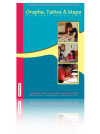In 2007, the first year of the fourth cycle of national monitoring, three areas were assessed: science, art, and the use of graphs, tables and maps. This report presents details and results of the assessments of students’ skills in the use of graphs, tables and maps. Understanding and using information presented in the form of graphs, tables and maps is an important part of everyday life in our community. This report highlights two aspects of the use of graphs, tables and maps: extracting and interpreting information, and constructing or completing graphs, tables and maps.
New Zealand’s National Education Monitoring Project commenced in 1993, with the task of assessing and reporting on the achievement of New Zealand primary school children in all areas of the school curriculum. Children are assessed at two class levels: year 4 (halfway through primary education) and year 8 (at the end of primary education). Different curriculum areas and skills are assessed each year, over a four-year cycle. The main goal of national monitoring is to provide detailed information about what children know, think and can do, so that patterns of performance can be recognised, successes celebrated, and desirable changes to educational practices and resources identified and implemented.
Each year, random samples of children are selected nationally, then assessed in their own schools by teachers specially seconded and trained for this work. Task instructions are given orally by teachers, through video presentations, on laptop computers, or in writing. Many of the assessment tasks involve the children in the use of equipment and materials. Their responses are presented orally, by demonstration, in writing, in computer files, or through other physical products. Many of the responses are recorded on videotape for subsequent analysis.
Key Results
Year 4 and year 8 students show a basic ability to read and interpret graphs, tables and maps, with year 8 students showing marked improvement over year 4 students. Tasks that involve interpreting information, combining information, or using information to make inferences or deductions are particularly difficult for year 4 students. Many year 8 students are skilled at producing or completing graphs and tables, with year 4 students having substantially more difficulty in this area. When a task requires the construction of a graph or table without a model to work from, many students at both years have trouble. Overall performance levels were very similar in 2007 and 2003, and differences between demographic subgroups had not changed substantially. On average, across the range of 2007 tasks at both year levels, differences in performance between boys and girls were very small; Pakeha students performed better than Māori students by moderate to large margins; Pakeha students performed better than Pasifika students by large margins; and students for whom the predominant language at home was English performed slightly to moderately better than other students.

